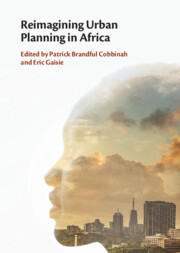Book contents
- Reimagining Urban Planning in Africa
- Reimagining Urban Planning in Africa
- Copyright page
- Contents
- Contributors
- Foreword
- Preface
- Acknowledgements
- Abbreviations
- Part I Understanding Sustainable Urban Planning in Africa
- Part II Case Studies on Urban Planning in African Countries
- Part III Sustainable Urban Planning in Africa
- Index
- References
Part I - Understanding Sustainable Urban Planning in Africa
Published online by Cambridge University Press: 07 December 2023
- Reimagining Urban Planning in Africa
- Reimagining Urban Planning in Africa
- Copyright page
- Contents
- Contributors
- Foreword
- Preface
- Acknowledgements
- Abbreviations
- Part I Understanding Sustainable Urban Planning in Africa
- Part II Case Studies on Urban Planning in African Countries
- Part III Sustainable Urban Planning in Africa
- Index
- References
Summary

- Type
- Chapter
- Information
- Reimagining Urban Planning in Africa , pp. 1 - 106Publisher: Cambridge University PressPrint publication year: 2023



